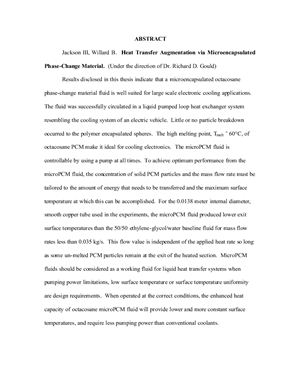На наглийском языке. Магистерская диссертация. Работа выполнена в
North Carolina State University, 2002, 70+XIII pp.
Abstract
Results disclosed in this thesis indicate that a microencapsulated octacosane phase-change material fluid is well suited for large scale electronic cooling applications.
The fluid was successfully circulated in a liquid pumped loop heat exchanger system
resembling the cooling system of an electric vehicle. Little or no particle breakdown
occurred to the polymer encapsulated spheres. The high melting point, Tmelt 60°C, of
octacosane PCM make it ideal for cooling electronics. The microPCM fluid is
controllable by using a pump at all times. To achieve optimum performance from the
microPCM fluid, the concentration of solid PCM particles and the mass flow rate must be tailored to the amount of energy that needs to be transferred and the maximum surface temperature at which this can be accomplished. For the 0.0138 meter inteal diameter, smooth copper tube used in the experiments, the microPCM fluid produced lower exit surface temperatures than the 50/50 ethylene-glycol/water baseline fluid for mass flow rates less than 0.035 kg/s. This flow value is independent of the applied heat rate so long as some un-melted PCM particles remain at the exit of the heated section. MicroPCM fluids should be considered as a working fluid for liquid heat transfer systems when pumping power limitations, low surface temperature or surface temperature uniformity are design requirements. When operated at the correct conditions, the enhanced heat capacity of octacosane microPCM fluid will provide lower and more constant surface temperatures, and require less pumping power than conventional coolants
Abstract
Results disclosed in this thesis indicate that a microencapsulated octacosane phase-change material fluid is well suited for large scale electronic cooling applications.
The fluid was successfully circulated in a liquid pumped loop heat exchanger system
resembling the cooling system of an electric vehicle. Little or no particle breakdown
occurred to the polymer encapsulated spheres. The high melting point, Tmelt 60°C, of
octacosane PCM make it ideal for cooling electronics. The microPCM fluid is
controllable by using a pump at all times. To achieve optimum performance from the
microPCM fluid, the concentration of solid PCM particles and the mass flow rate must be tailored to the amount of energy that needs to be transferred and the maximum surface temperature at which this can be accomplished. For the 0.0138 meter inteal diameter, smooth copper tube used in the experiments, the microPCM fluid produced lower exit surface temperatures than the 50/50 ethylene-glycol/water baseline fluid for mass flow rates less than 0.035 kg/s. This flow value is independent of the applied heat rate so long as some un-melted PCM particles remain at the exit of the heated section. MicroPCM fluids should be considered as a working fluid for liquid heat transfer systems when pumping power limitations, low surface temperature or surface temperature uniformity are design requirements. When operated at the correct conditions, the enhanced heat capacity of octacosane microPCM fluid will provide lower and more constant surface temperatures, and require less pumping power than conventional coolants

